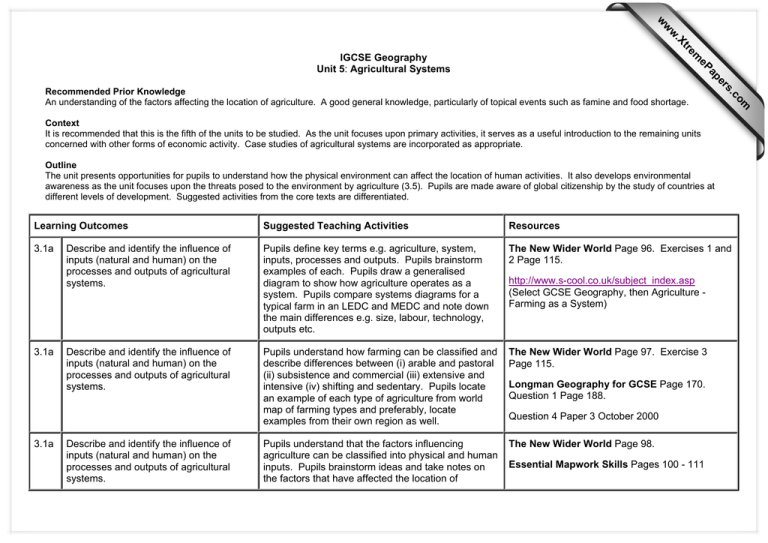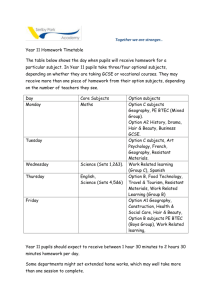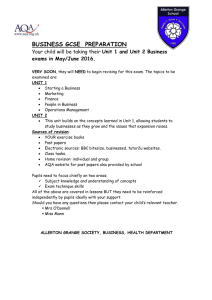www.XtremePapers.com IGCSE Geography Unit 5
advertisement

e tr .X w w w om .c Recommended Prior Knowledge An understanding of the factors affecting the location of agriculture. A good general knowledge, particularly of topical events such as famine and food shortage. s er ap eP m IGCSE Geography Unit 5: Agricultural Systems Context It is recommended that this is the fifth of the units to be studied. As the unit focuses upon primary activities, it serves as a useful introduction to the remaining units concerned with other forms of economic activity. Case studies of agricultural systems are incorporated as appropriate. Outline The unit presents opportunities for pupils to understand how the physical environment can affect the location of human activities. It also develops environmental awareness as the unit focuses upon the threats posed to the environment by agriculture (3.5). Pupils are made aware of global citizenship by the study of countries at different levels of development. Suggested activities from the core texts are differentiated. Learning Outcomes Suggested Teaching Activities Resources 3.1a Describe and identify the influence of inputs (natural and human) on the processes and outputs of agricultural systems. Pupils define key terms e.g. agriculture, system, inputs, processes and outputs. Pupils brainstorm examples of each. Pupils draw a generalised diagram to show how agriculture operates as a system. Pupils compare systems diagrams for a typical farm in an LEDC and MEDC and note down the main differences e.g. size, labour, technology, outputs etc. The New Wider World Page 96. Exercises 1 and 2 Page 115. Describe and identify the influence of inputs (natural and human) on the processes and outputs of agricultural systems. Pupils understand how farming can be classified and describe differences between (i) arable and pastoral (ii) subsistence and commercial (iii) extensive and intensive (iv) shifting and sedentary. Pupils locate an example of each type of agriculture from world map of farming types and preferably, locate examples from their own region as well. The New Wider World Page 97. Exercise 3 Page 115. Pupils understand that the factors influencing agriculture can be classified into physical and human inputs. Pupils brainstorm ideas and take notes on the factors that have affected the location of The New Wider World Page 98. 3.1a 3.1a Describe and identify the influence of inputs (natural and human) on the processes and outputs of agricultural systems. http://www.s-cool.co.uk/subject_index.asp (Select GCSE Geography, then Agriculture Farming as a System) Longman Geography for GCSE Page 170. Question 1 Page 188. Question 4 Paper 3 October 2000 Essential Mapwork Skills Pages 100 - 111 Learning Outcomes Suggested Teaching Activities Resources agriculture. http://www.s-cool.co.uk/subject_index.asp Select GCSE Geography, then Agriculture Factors Affecting farm Type) Question 4 Paper 3 November 1998 3.1a 3.1b 3.1b 3.5 Describe and identify the influence of inputs (natural and human) on the processes and outputs of two agricultural systems: large-scale commercial farming and small-scale subsistence farming. Recognise the causes of shortage of food. Recognise the effects of shortage of food and describe possible solutions to them. Pupils work in small groups to research a case study for each type of agriculture to include: location map and description, systems diagram, the scale, processes and outputs, the factors influencing the location of each system. Small groups present their ideas to the rest of the group with handouts. Case Studies: Large-scale commercial - e.g. plantation agriculture in Brazil, extensive commercial cereal farming in Canadian Prairies, extensive livestock production in the American mid-west. Small scale subsistence farming - e.g. rice farming in the Ganges Valley. Other case studies can be selected as appropriate. Centres may wish to make use of local examples. The New Wider World Pages 100 - 105. Page 112 - 113. Pupils define the key terms famine and food shortage and describe the difference between the two. Pupils explain the causes of famine and food shortage using textbook and internet references to include pests, disease, soil erosion, natural disasters e.g. drought/floods and human factors such as civil war, lack of distribution and low capital investment. The New Wider World Pages 110 - 111. Exercise 8 Page 117. Pupils understand the response of governments in LEDC’s to try to overcome food shortages. Pupils write a report on policies and strategies to include The Green Revolution – successes and failures. Pupils understand how The Green Revolution had positive social and economic impacts for some but The New Wider World Page 113. Exercise 9 Page 115. Longman Geography for GCSE Page 180 - 187. Essential Mapwork Skills Pages 108 - 111 http://www.s-cool.co.uk/subject_index.asp (Select GCSE Geography, then Agriculture Types of Farming) Question 6 Paper 2 November 1999 Question 5 Paper 3 November 1998 Longman Geography for GCSE Pages 178 179. Question 5 Paper 3 November 1998 Longman Geography for GCSE Page 180 -181. Learning Outcomes Suggested Teaching Activities Resources caused losses for others. http://www.s-cool.co.uk/subject_index.asp (Select GCSE Geography, then Agriculture - How to Raise Food Production in LEDC’s) http://www.feedingminds.org/ www.cgiar.org/irri/ Question 5 Paper 1/2 October 2000 3.5 The threat posed to the environment by agriculture. Pupils research and take notes, with relevant examples, on the impact of agriculture upon the environment to include: fertilisers, pesticides, hedgerow removal, salinisation, soil erosion and desertification, loss of habitats. The New Wider World Pages 108 and 109. Exercise 7 Page 117. http://www.s-cool.co.uk/ (Select AS Geography, then Ecosystems - Human Impact upon Soils. Select Agriculture - Impact of Agriculture on the Physical Environment. http://www.scool.co.uk/topic_quicklearn.asp?loc=ql&topic_id=1 30&quicklearn_id=4&subject_id=20 (Select Agriculture, then Agricultural Policies and Change) http://www.botany.uwc.ac.za/envfacts/facts/erosio n.htm





